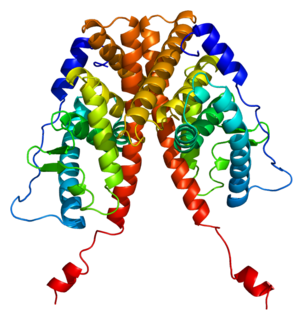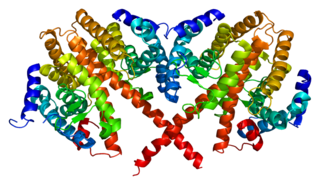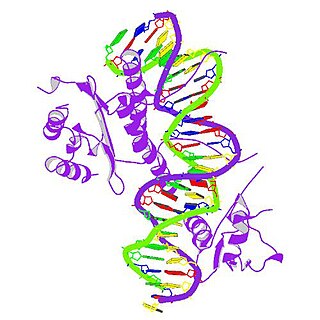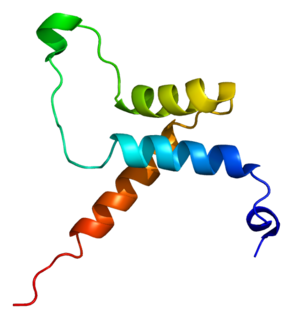Transcription factor GATA-5 is a protein that in humans is encoded by the GATA5 gene. [5] [6]
Transcription factor GATA-5 is a protein that in humans is encoded by the GATA5 gene. [5] [6]
The protein encoded by this gene is a transcription factor that contains two GATA-type zinc fingers. The encoded protein is known to bind to hepatocyte nuclear factor-1alpha (HNF-1alpha), and this interaction is essential for cooperative activation of the intestinal lactase-phlorizin hydrolase promoter. In other organisms, similar proteins may be involved in the establishment of cardiac smooth muscle cell diversity. [6]
Gata5 is a transcription factor. Gata5 regulates the proper development of the heart. Early in embryo development, Gata5 helps in making sure that there are enough heart muscle precursor cells produced to differentiate into the final myocardial cells. It also regulates other genes that are crucial to successful heart development. [7] As pregnancy progresses, Gata 5 is involved in the specification of the heart tissue that becomes the ventricles. Problems can arise when Gata5 is overexpressed. This overexpression can lead to ectopic foci. Ectopic foci are also known as ectopic pacemakers. They are bundles of cells that can cause cardiac pacing that are located in places in the heart where they're not supposed to be. These cells can become excited before the heart is supposed to be excited. This causes the heart to beat and thus contract before it should. Oftentimes, this is not a big deal and the heart naturally reverts to its normal pacing. However, if it's caused by problems with development in the heart – if Gata5 did not express properly in the embryo- then this can lead to constant ectopic foci problems. These problems include tachycardia (the heart beating too fast), bradycardia (the heart beating too slow), or ventricular fibrillation [8] which is a serious condition where the ventricles of the heart aren't pumping consistently and can't get blood out to the body.

Estrogen receptor alpha (ERα), also known as NR3A1, is one of two main types of estrogen receptor, a nuclear receptor that is activated by the sex hormone estrogen. In humans, ERα is encoded by the gene ESR1.

Hepatocyte nuclear factor 4 alpha (HNF4A) also known as NR2A1 is a nuclear receptor that in humans is encoded by the HNF4A gene.

HNF1 homeobox A, also known as HNF1A, is a human gene on chromosome 12. It is ubiquitously expressed in many tissues and cell types. The protein encoded by this gene is a transcription factor that is highly expressed in the liver and is involved in the regulation of the expression of several liver-specific genes. Mutations in the HNF1A gene have been known to cause diabetes. The HNF1A gene also contains one of 27 SNPs associated with increased risk of coronary artery disease.

Homeobox protein CDX-2 is a protein that in humans is encoded by the CDX2 gene. The CDX2 protein is a homeobox transcription factor expressed in the nuclei of intestinal epithelial cells, playing an essential role in the development and function of the digestive system. CDX2 part of the ParaHox gene cluster, a group of three highly conserved developmental genes present in most vertebrate species. Together with CDX1 and CDX4, CDX2 is one of three caudal-related genes in the human genome.

Transcription factor GATA-4 is a protein that in humans is encoded by the GATA4 gene.

HNF1 homeobox B, also known as HNF1B or transcription factor 2 (TCF2), is a human gene.

Cyclic AMP-dependent transcription factor ATF-3 is a protein that, in humans, is encoded by the ATF3 gene.

GATA2 or GATA-binding factor 2 is a transcription factor, i.e. a nuclear protein which regulates the expression of genes. It regulates many genes that are critical for the embryonic development, self-renewal, maintenance, and functionality of blood-forming, lympathic system-forming, and other tissue-forming stem cells. GATA2 is encoded by the GATA2 gene, a gene which often suffers germline and somatic mutations which lead to a wide range of familial and sporadic diseases, respectively. The gene and its product are targets for the treatment of these diseases.

Cyclic AMP-dependent transcription factor ATF-1 is a protein that in humans is encoded by the ATF1 gene.

Serum response factor, also known as SRF, is a transcription factor protein.

COUP-TF1 also known as NR2F1 is a protein that in humans is encoded by the NR2F1 gene. This protein is a member of nuclear hormone receptor family of steroid hormone receptors.

DNA damage-inducible transcript 3, also known as C/EBP homologous protein (CHOP), is a pro-apoptotic transcription factor that is encoded by the DDIT3 gene. It is a member of the CCAAT/enhancer-binding protein (C/EBP) family of DNA-binding transcription factors. The protein functions as a dominant-negative inhibitor by forming heterodimers with other C/EBP members, preventing their DNA binding activity. The protein is implicated in adipogenesis and erythropoiesis and has an important role in the cell's stress response.

GATA3 is a transcription factor that in humans is encoded by the GATA3 gene. Studies in animal models and humans indicate that it controls the expression of a wide range of biologically and clinically important genes.

Transcription factor GATA-6, also known as GATA-binding factor 6 (GATA6), is protein that in humans is encoded by the GATA6 gene. The gene product preferentially binds (A/T/C)GAT(A/T)(A) of the consensus binding sequence.

Transcriptional enhancer factor TEF-1 also known as TEA domain family member 1 (TEAD1) and transcription factor 13 (TCF-13) is a protein that in humans is encoded by the TEAD1 gene. TEAD1 was the first member of the TEAD family of transcription factors to be identified.

Krueppel-like factor 12 is a protein that in humans is encoded by the KLF12 gene.

Homeobox protein Hox-C11 is a protein that in humans is encoded by the HOXC11 gene.

Forkhead box protein A1 (FOXA1), also known as hepatocyte nuclear factor 3-alpha (HNF-3A), is a protein that in humans is encoded by the FOXA1 gene.

Forkhead box protein A2 (FOXA2), also known as hepatocyte nuclear factor 3-beta (HNF-3B), is a transcription factor that plays an important role during development, in mature tissues and, when dysregulated or mutated, also in cancer.

Hepatocyte nuclear factor 3-gamma (HNF-3G), also known as forkhead box protein A3 (FOXA3) or transcription factor 3G (TCF-3G) is a protein that in humans is encoded by the FOXA3 gene.
This article incorporates text from the United States National Library of Medicine, which is in the public domain.